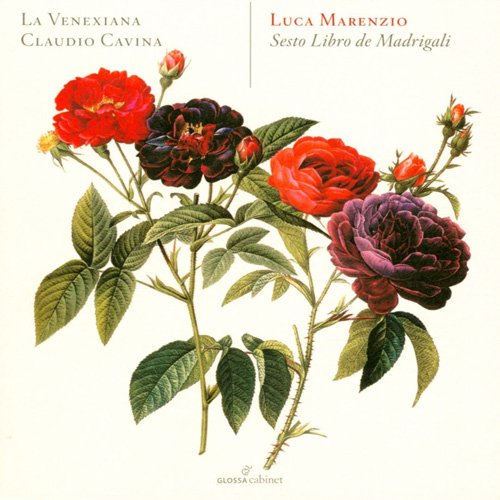La Venexiana & Claudio Cavina - Luca Marenzio: Sesto Libro De Madrigali (2011)

Artist: La Venexiana, Claudio Cavina
Title: Luca Marenzio: Sesto Libro De Madrigali
Year Of Release: 2011
Label: Glossa
Genre: Classical
Quality: FLAC (image + .cue)
Total Time: 54:07 min
Total Size: 220 MB
WebSite: Album Preview
Tracklist:Title: Luca Marenzio: Sesto Libro De Madrigali
Year Of Release: 2011
Label: Glossa
Genre: Classical
Quality: FLAC (image + .cue)
Total Time: 54:07 min
Total Size: 220 MB
WebSite: Album Preview
01 S’io parto, i’ moro e pur partir conviene
02 Clori nel mio partire
03 Donna de l’alma mia, de la mia vita
04 Anima cruda si, ma pero bella
05 Udite, lagrimosi
06 Stillo l’anima in pianto
07 Ah, dolente partita!
08 Ben’ho del car’oggetto i sensi privi
09 Amor, se giusto sei
10 Hor chi, Clori beata
11 Deh Tirsi, Tirsi, anima mia, perdona
12 Clori mia, Clori dolce, oh sempre nuovo
13 Mentre qual viva pietra
14 Voi bramate ch’io moia
15 Clori mia, Clori dolce, oh sempre nuovo
16 Rimanti in pace, a la dolente e bella
17 Ecco Maggio seren, chi l’ha vestito
18 Cantiam la bella Clori
"For the non-specialist," observed Early Music World, "detailed consideration of Marenzio's large body of madrigals remains a vain quest in the light of the lack of comprehensive accessibility to either printed or recorded music." This release from Spain's Glossa label helps rectify the situation with precise yet stylistically sensitive performances of a key set of Luca Marenzio madrigals from the vocal group La Venexiana. Marenzio was the most famous Italian madrigalist of the late 16th century, known to English composers as well as those on home ground (and he traveled as far as Poland, perhaps having had to make himself scarce after an illicit relationship with a relative of the Pope). General listeners may have the impression that the monodic style of Monteverdi's operas and later madrigal books represented a sharp break from the polyphonic madrigal, but in fact the evolution was more gradual; opera had predecessors in madrigals in a more declamatory style and in big dramatic presentations on pastoral themes called intermedi. Marenzio's Sixth Book of Madrigals, published in 1594 and recorded here, shows the full range of his style, from tortured chromaticism that approaches the style of the last and most decadent of the Renaissance madrigalists, Carlo Gesualdo, to broad, pleasant pastoral scenes featuring the shepherdesses Clori and Amarilli that clearly pointed the way toward what was to come. The inclusion of a lute version of one piece, Clori mia, Clori dolce, oh sempre novo (My Cloris, sweet Cloris, ah, always new), shows how advanced the idea of a soprano melodic line had already become in Marenzio's hands. Throughout, Marenzio's exquisitely sensitive responses to text are beautifully rendered by the singers, but buyers of the CD version should note that texts are given in Italian only. Strongly recommended for lovers of madrigals in any language. -- James Manheim



![Ilja Reijngoud, Ed Verhoeff - Peace (2025) [Hi-Res] Ilja Reijngoud, Ed Verhoeff - Peace (2025) [Hi-Res]](https://www.dibpic.com/uploads/posts/2025-12/1765496183_s8v4szro856ma_600.jpg)

![Club Bolero, Armik - A Day in Brazil (2007) [Hi-Res] Club Bolero, Armik - A Day in Brazil (2007) [Hi-Res]](https://img.israbox.com/img/2025-12/15/5l607nskcv4xb0n237d8ngs7q.jpg)

![Nicole Zuraitis - Holiday Up EP (2025) [Hi-Res] Nicole Zuraitis - Holiday Up EP (2025) [Hi-Res]](https://www.dibpic.com/uploads/posts/2025-12/1765478937_cover.jpg)
![Tomasz Stanko, Polskie Radio - Jazz Rock Company: Live at Akwarium (Polish Radio Sessions vol. 6/6) (2025) [Hi-Res] Tomasz Stanko, Polskie Radio - Jazz Rock Company: Live at Akwarium (Polish Radio Sessions vol. 6/6) (2025) [Hi-Res]](https://www.dibpic.com/uploads/posts/2025-12/1765796554_cover.jpg)